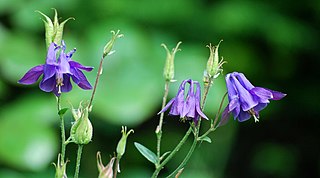
Aquilegia is a genus of about 60–70 species of perennial plants that are found in meadows, woodlands, and at higher altitudes throughout the Northern Hemisphere, known for the spurred petals of their flowers.

Aquilegia formosa, the crimson columbine, western columbine, or (ambiguously) "red columbine", is a common wildflower native to western North America, from Alaska to Baja California, and eastward to Montana and Wyoming.

Aquilegia canadensis, the Canadian or Canada columbine, eastern red columbine, or wild columbine, is a species of flowering plant in the buttercup family Ranunculaceae. It is an herbaceous perennial native to woodland and rocky slopes in eastern North America, prized for its red and yellow flowers. It readily hybridizes with other species in the genus Aquilegia.

Aquilegia coerulea, the Colorado blue columbine, is a species of flowering plant in the buttercup family Ranunculaceae, native to the Rocky Mountains, USA. Aquilegia coerulea is the state flower of Colorado.
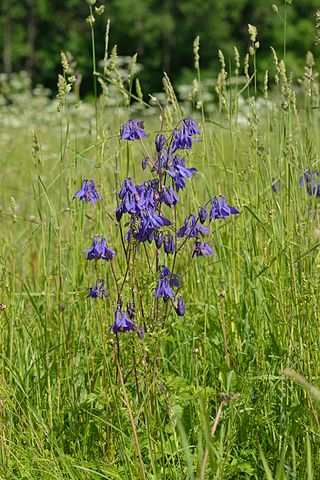
Aquilegia vulgaris is a species of columbine native to Europe with common names that include: European columbine, common columbine, granny's nightcap, and granny's bonnet. It is a flowering herbaceous perennial plant growing to 1.2 m tall, with branched, thinly hairy stems. The leaves are biternate; each leaf has three groups of three leaflets. The flowers, in various shades of purple, blue, pink and white, are pendent or horizontal with strongly hooked spurs, and appear in early summer.
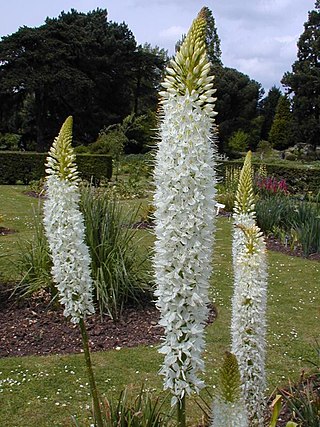
Eremurus is a genus of deciduous perennial flowers in the family Asphodelaceae. They are also known as the foxtail lilies or desert candles. They are native to eastern Europe in, and temperate Asia from Turkey to China, with many species in Central Asia.

Iris subg. Scorpiris, commonly called Juno, is a subgenus of Iris, representing the smooth-bulbed bulbous irises. For a while it was an independent genus Juno Tratt. in some classifications.
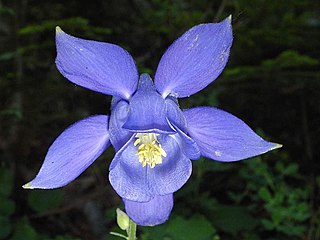
Aquilegia bertolonii, common name Bertoloni columbine, is a species of flowering plant in the family Ranunculaceae, native to Southern France and Italy. Growing to 30 cm (12 in) in height, it is an alpine herbaceous perennial. In early summer each erect stem produces up to four spurred, blue-purple flowers.

Aquilegia flabellata, common name fan columbine or dwarf columbine, is a species of flowering perennial plant in the genus Aquilegia (columbine), of the family Ranunculaceae.

Aquilegia pyrenaica, common name Pyrenean columbine, is a species of flowering plant in the family Ranunculaceae. It is endemic to the Pyrenees where it grows on grassland and in rocky places. It was first described in 1805 by Augustin Pyramus de Candolle who gave it the name Aquilegia pyrenaica.
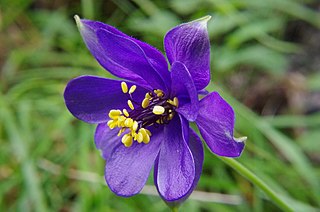
Aquilegia alpina, the alpine columbine or breath of God, is a species of flowering plant in the family Ranunculaceae, native to the Alps, where it is typically found growing on carbonate bedrock.

Aquilegia viridiflora, commonly known as the green columbine or green-flowered columbine, is a species of flowering plant in the buttercup family. Its native range is southern Siberia to northern China, and Japan. It is an herbaceous perennial, and grows 15 cm to 50 cm tall, with a maximum spread of approximately 30 cm. Although it is grown as an ornamental, it may be considered a weed.

Aquilegia barnebyi, commonly known as the oil shale columbine or Barneby's columbine, is a perennial species of flowering plant in the buttercup family, with a native range comprising northeastern Utah and northwestern Colorado in the United States. It is named after Rupert Charles Barneby, who, with Harry Dwight Dillon Ripley, first discovered it in Colorado.

Aquilegia skinneri, commonly known as the Mexican columbine or Skinner's columbine, is a species of flowering plant in the buttercup family.

Aquilegia bernardii, common name Bernard's columbine, is a perennial species of plant in the family Ranunculaceae, endemic to Corsica. It is likely named after the French plant collector Pierre Frédéric Bernard.

Aquilegia desertorum, the desert columbine, is a perennial species of plant in the family Ranunculaceae, native to New Mexico, Arizona, and southwest Utah. It inhabits open rocky limestone areas between 2000m and 2500m altitude.

Aquilegia dinarica, the Dinaric columbine, is a perennial species of plant in the family Ranunculaceae, endemic to the Dinaric Alps of northern Albania, Bosnia and Herzegovina, Croatia, and Montenegro.

Aquilegia einseleana, or Einsele's columbine, is a perennial species of plant in the family Ranunculaceae, endemic to the central and eastern Alps of Slovenia and small areas of Germany, Austria, and Italy.

Aquilegia glandulosa, the Siberian columbine, is a perennial species of plant in the family Ranunculaceae, native to northern and central Asia.

Aquilegia jonesii, or Jones' columbine, is a perennial species of plant in the family Ranunculaceae, endemic to Alberta, Montana, and Wyoming.




















